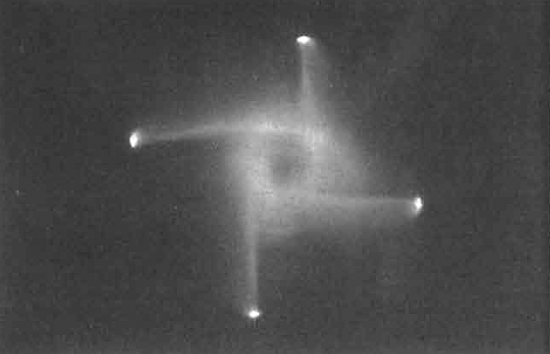
March 27, 2020
Winston Bostick March 5, 1916 – January 19, 1991
Dr. Winston H. Bostick was born in Freeport, IL. He earned acclaim as a plasma pioneer, and is discussed in many Pictures of the Day. He attended the University of Chicago, where he earned a Ph.D in physics, beginning his lifelong research into electromagnetic pinch effects, including plasmoids.
Bostick and colleagues built a plasma gun in the 1950s, in order to study the behavior of plasmoids and why they seem to violate the space charge law. Space charge occurs as a region of electric charge that is unbounded in space—a “cloud” of electricity, either positive or negative. Within the Solar System, thermionic emissions from the Sun create a negative space charge. His plasmoids were too powerful; able to instantly melt holes through metal plates or explode violently.
Bostick also found that when plasmoids travel across a magnetic field, they become twisted. Physicist Eric Lerner is using that principle, attempting to create nuclear fusion with a plasma gun. Within the plasmoids, Bostick discovered levels of detail that included vortices and filamentary structures. Such entities bring to mind a quote from Hannes Alfven:
“The plasma exhibited striations and double-layers, the electron distribution was non-Maxwellian, there were all sorts of oscillations and instabilities.”
Plasma does not lend itself to elegant theories, because of its inherent instability. Plasma instabilities are not well-known to the general public, or among astronomers. They refer to distortions that occur when plasmas are generated and confined. They are often confused with phenomena observed in fluid interactions: Kelvin-Helmholtz or Rayleigh-Taylor instabilities, for instance.
Since plasmas are conventional matter with a small percentage of ionized particles, they do not conform to kinetic energy principles, alone. Rather, matter in the plasma state is strongly influenced by electromagnetism, and does not obey any other force, including gravity, except peripherally. Many types of instability are observed in plasma: diocotron instabilities, kink instabilities, edge instabilities (that make fusion reactors impossible to control), sausage instabilities (deformations in plasma flow), reactive instabilities, etc.
it is the movement of electric charges in plasma that forms electromagnetic fields that constrict the electric charge flow. As previous Picture of the Day articles point out, the constricted channel is known as a “Bennett pinch,” or “z-pinch.” The pinched electric filaments remain coherent over long distances, forming helical structures that can transmit power through space. That phenomenon is what scientists refer to as flux ropes.
Plasmoids are found throughout the cosmos. Recent investigations into Voyager data reveals plasmoids in the vicinity of the planet Uranus. More on that topic at a later date.
Stephen Smith
The Thunderbolts Picture of the Day is generously supported by the Mainwaring Archive Foundation.












